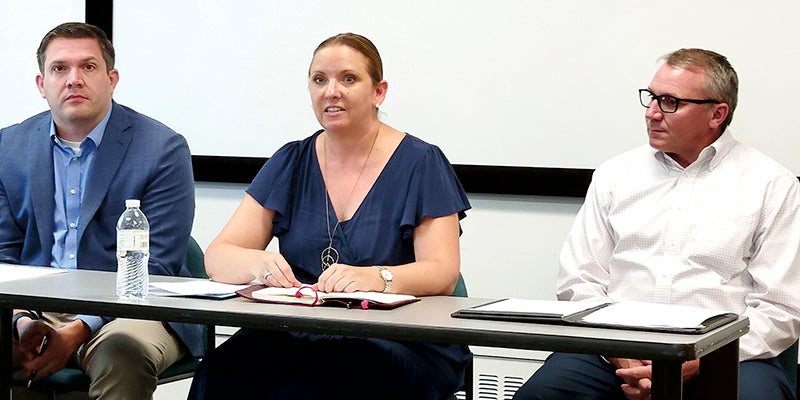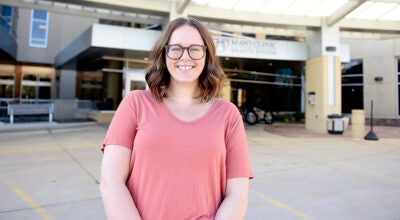Answering the call of better rural ambulance service
Published 5:00 pm Wednesday, August 16, 2023

- Michael Juntunen, from left, Julie Tesch and Mark Jones took part in a round table discussion Wednesday at rural ambulance challenges. Eric Johnson/photodesk@austindailyherald.com
|
Getting your Trinity Audio player ready...
|
Round table Wednesday casts eye on challenges facing today’s emergency responders
Mark Jones, executive director for the Minnesota Rural Health Association, had a stark warning for those attending a round table discussion on the challenges faced by rural ambulance services Wednesday.
“There has been progress made,” Jones said at Mayo Clinic Health Systems-Austin, but added: “If we don’t make progress there are going to be missed calls. There’s going to be ambulance services that just close.”
Jones was joined by Center for Rural Policy & Development President and CEO Julie Tesch and Michael Juntunen, Minnesota Ambulance Association president elect and coordinator for Community Paramedicine, Mayo Clinic Ambulance.
Wednesday’s discussion, titled “The Future of Rural Ambulance and EMS” was a chance to bring together community, health care and business leaders to talk about what the future entails for rural ambulance service.
The discussion comes well before the beginning of the 2024 legislative session in February, but is actually a continuation of concerns brought to the legislature in this last session.
Primarily, those concerns revolve around how rural EMS and ambulance services are currently operated in terms of funding and manpower.
“It’s pretty easy … it’s workforce and funding,” Jones said. “They are the chicken and the egg, which one came first? At the core of the problem is that it’s stagnant. We’re still relying on community service and volunteers.”
The panel addressed the issue by saying that when ambulance services started to be established in the 1970s, it was treated as a transportation service, rather than a healthcare option, something that had its roots much deeper in history.
“That funding is stagnant,” Tesch said. “You get that separate bill from the ambulance, separate from the hospital.”
Juntunen said that for the model to be reliable, a service would have to rely on around 1,500 transports a year to fund a full time ambulance.
But that becomes with a challenge in a world that is also seeing more cross facility transports that are thinning out available staff as well as a world competing for time in the lives of volunteers.
“A lot of people out there are working on ambulances — they are mechanics, funeral home directors, people who have other jobs,” Juntunen said, reminding people that in the 70s emergency response was much different. “They understood basic CPR. There was less training involved in being on an ambulance (crew).”
That has changed dramatically over the years as training has become more specialized to handle emergencies.
Unfortunately, it also goes back to staffing, which is experiencing a shortage in rural areas.
“When we look at smaller rural services, they are relying on volunteers and part time,” Jones said. “Their time is spread so thin. We have our jobs, families are going and doing more. We can just do more.”
The under-staffing can lead to more cases of burnout as volunteers are staying with ambulance services simply because they feel they have to stay on because there is no one else.
For services that respond mostly to medical calls in places like nursing homes, attending a more serious medical facility can be draining — both physically and mentally.
“When I do get a pediatric cardiac arrest — that can be a pretty big burden on people’s shoulders,” Juntunen said.
The question is ultimately what comes next, and that’s an area that comes with a little bit of regret, as panelists admitted that maybe advocates haven’t done enough sooner to get the word out.
“We probably did hold off a little too long before banging the drum,” Juntunen said, as discussion turned to just how many don’t know this is a problem.
Tesch said, the crisis in rural ambulance service is similar to that of child care where many didn’t understand just how serious the problem was until the COVID-19 pandemic hit. While smaller groups understood the coming issue, many outside of those groups didn’t know just how deep of a problem it was.
“All of a sudden, a pandemic or something crazy happens and you don’t have it,” she said. “The outcome is people suffer and die.”
For many, change will come when the model is altered and funding is made available on a more consistent basis, but it might also come as smaller communities begin having discussions with each other.
Something Jones said has been hard to do previously.
“It’s this model. We don’t know what to do to move it forward,” he said. “If we had the money, then maybe we can have the staff and things get better.”
Juntunen agreed, saying: “We do need to look at new ways of doing things. When they are faced with struggles, facing them for awhile, they don’t know that the next step is reaching out to neighbors, ‘why don’t we combine these resources?’”
“Looking at doing things differently is going to be an important part of the future,” he added.




